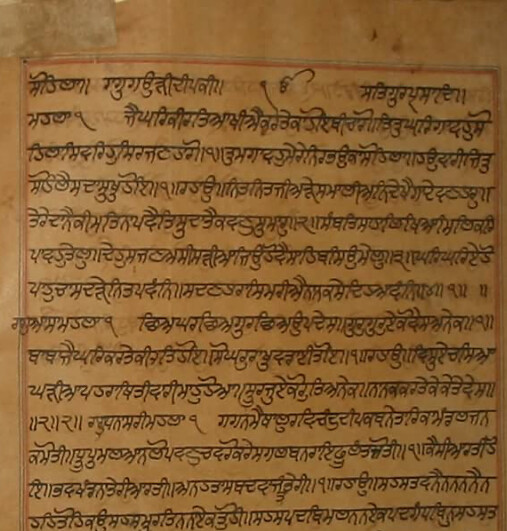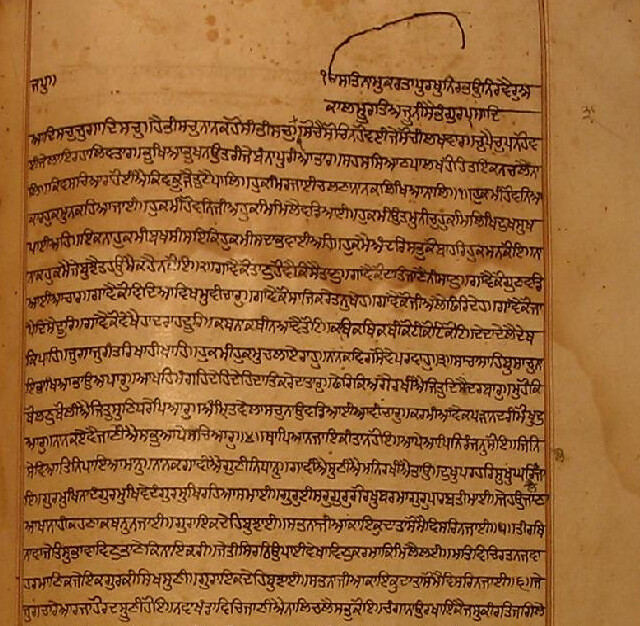jaskirat Wrote:
-------------------------------------------------------
> Kulbir Singh Wrote:
> --------------------------------------------------
> -----
> > 4. Another thing that is clear from this
> picture
> > is that "Jap" is not part of Mool Mantra and is
> a
> > Sirlekh. How else did this Baani get the name
> > "Jap" jee Sahib? If we consider "Jap" to be
> part
> > of the Mool Mantr, then what would be the name
> of
> > this Baani?
> >
> > Kulbir Singh
>
>
> Aim : To bring out the difference between Maha
> Mantar and Mool Mantar for Sikh Sangat.
> Disclaimer : Daas has tried to do the Loose
> Translation in English so the words used by Daas
> may not bring out full essence of Gurmukhi.
>
> Once Gyani Jee explained and Daas has understood
> following points.
>
> 1) Till ਗੁਰ ਪ੍ਰਸਾਦਿ
> (Gurprasaad) it is Maha Mantar given by One and
> only One Akal Purakh Waheguru to Sri Guru Nanak
> Dev Jee (during Sri Sultanpur Sahib Bein/Beas
> River incident when Sri Guru Nanak Dev Ji went to
> see Akal Purakh).
>
> 2) After 3 days Sri Guru Nanak Dev Ji appeared
> (pragat) in Sant Ghat (on banks of Bein/Beas river
> or Madiyan vich) and recited (Uchaaran) Mool
> Mantar till ਨਾਨਕ ਹੋਸੀ ਭੀ
> ਸਚੁ (Nanak Hosi Bhi Sach).
>
> 3) Sri Guru Nanak Dev Ji explained, “Till
> ਗੁਰ ਪ੍ਰਸਾਦਿ (Gurprasaad) the
> Maha Mantar was given (Bakshish) to me by Akal
> Purak Ji who is my Satguru”. Nirgun Swaroop is
> Father (Akal Purakh) and Sargun Swaroop is Son
> (Sri Guru Nanak Dev Ji).
>
> 4) Akal Purakh gave Hukam to Sri Guru Nanak Dev Ji
> that “Duniya Vich Ja Ke Naam Japao fir Dukhi
> Duniya Sukhi Ho Javegi”.
>
> 5) Sri Guru Nanak Dev Ji asked Akal Purakh “How
> the Swaroop of Akal Purakh till the “
> ਸੈਭੰ “ will be attained (Prapti)” ?
> Akal Purakh replied that by “ਗੁਰ
> ਪ੍ਰਸਾਦਿ (Gurprasaad)”, which comes
> after ਸੈਭੰ. This means that with Blessing
> of Sri Guru Nanak Dev Ji only the realisation of
> Akal Purakh will happen. Naam Daan Sri Guru Nanak
> Dev Ji di Bakshish de naal he milna hai.
>
> 6) Then Sri Guru Nanak Dev Ji did “Ustat” till
> ਨਾਨਕ ਹੋਸੀ ਭੀ ਸਚੁ (Nanak
> Hosi Bhi Sach). Then Sri Guru Nanak Dev Ji put
> “Eeka” after ਨਾਨਕ ਹੋਸੀ ਭੀ
> ਸਚੁ (Nanak Hosi Bhi Sach).
>
> 7) Conclusion : Till ਗੁਰ
> ਪ੍ਰਸਾਦਿ (Gurprasaad) Akal Purakh
> gave it to Sri Guru Nanak Dev Ji and then till
> “ਨਾਨਕ ਹੋਸੀ ਭੀ ਸਚੁ
> (Nanak Hosi Bhi Sach) with Eeka” was given by
> Sri Guru Nanak Dev Ji to Sangat.
>
> 8) After ਨਾਨਕ ਹੋਸੀ ਭੀ
> ਸਚੁ (Nanak Hosi Bhi Sach) with Eeka, One
> more EEKA comes at ਹੁਕਮਿ ਰਜਾਈ
> ਚਲਣਾ ਨਾਨਕ ਲਿਖਿਆ
> ਨਾਲਿ ॥੧॥ in Jap Ji Sahib. So Mool
> Mantar is till ਨਾਨਕ ਹੋਸੀ ਭੀ
> ਸਚੁ (Nanak Hosi Bhi Sach) with first Eeka.
>
> All this is known to Brahm Gyni person in 4th
> Awastha. All these truth is not known to person
> reached till 3 Awasthas namely Rajo Gun, Sato Gun
> and Tamo Gun (person whose Dib Dristhi is not open
> yet). Due to all this Agyan people are doing
> “Ched Kani With Bani and doing Ched Kani with
> Nirankaar”. Waho Waho Bani Nirankaar hai Te
> Jevad Avar Na Koi.
>
> After returning from Akal Purakh Ji’s visit, Sri
> Guru Nanak Dev Ji told Bebe Nanki Ji that in front
> (Sanmukh) of Akal Purakh He had recited
> “Sodar”. The “Sodar” which Sri Guru Nanak
> Dev Ji recited in front of Akal Purakh comes in
> “Rehraas Sahib”. The “Sodar” which Sri
> Guru Nanak Dev Ji recited to Bebe Nanaki Ji comes
> in starting of “Aasa Raag”. The “Sodar”
> which Sri Guru Nanak Dev Ji recited to Siddhas
> comes in “Jap Ji Sahib”. So in total 3 Sodar
> comes in Sri Guru Granth Sahib Ji.
>
> The above points comes from house of Damdami
> Taksal where Brahm Giani Sant Baba Bishan Singh ji
> Muralewale had most of the Anubhavi Arth of Sri
> Guru Granth Sahib Ji from his Brahm Gyan and gave
> this vidya to Sant Baba Gyani Sundar Singh Ji
> Khalsa Bhindrawale. Sant Baba Gyani Sundar Singh
> Ji Khalsa Bhindrawale then documented the meaning
> and taught Sant Baba Gurbachan Singh Ji Khalsa the
> same. Sant Baba Kartar Singh Ki Khalsa did
> compliation and created "Sateek Arth wali Pothi"
> and passed on this gyan to Sant baba Jarnail Singh
> Ji during 1974-77 when he was student at Damdami
> Taksal.
>
> DDM gave one serious advice that, "If you have
> still any doubt left then upgrade your Awastha and
> directly talk to Guru Jee Himself".

>
> Bhul Chuk Maaf.
>
> Waheguru Ji Ka Khalsa,
> Waheguru Ji Ki Fateh.
If only "upgrading" our avastha was as simple as you have just said it to be (perhaps I am missing something and their is a website where I can upgrade my Avastha OS ?) .
In all seriousness, by the time a Gurmukh reaches such a state where he/she is able to talk to Guru Sahib, these small, petty issues are just those small and petty.
 ਸਤਿਗੁਰਬਚਨਕਮਾਵਣੇਸਚਾਏਹੁਵੀਚਾਰੁ॥
ਸਤਿਗੁਰਬਚਨਕਮਾਵਣੇਸਚਾਏਹੁਵੀਚਾਰੁ॥

 ਸਤਿਗੁਰਬਚਨਕਮਾਵਣੇਸਚਾਏਹੁਵੀਚਾਰੁ॥
ਸਤਿਗੁਰਬਚਨਕਮਾਵਣੇਸਚਾਏਹੁਵੀਚਾਰੁ॥






